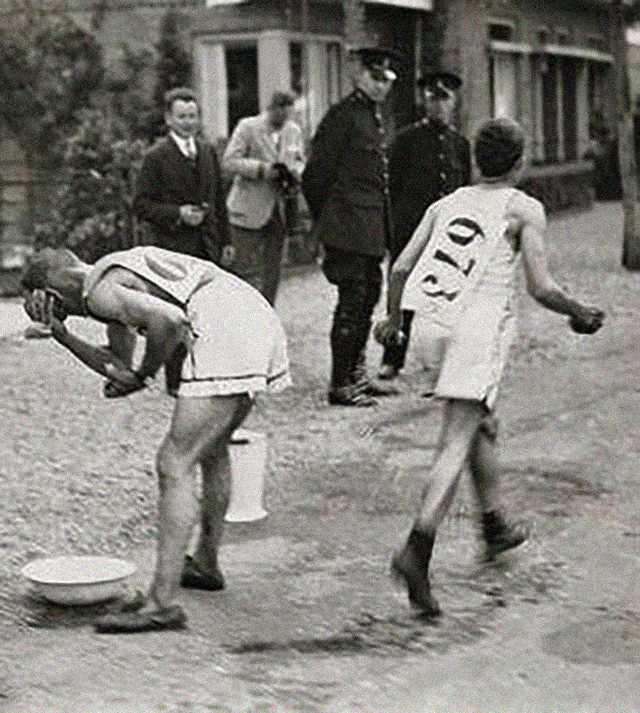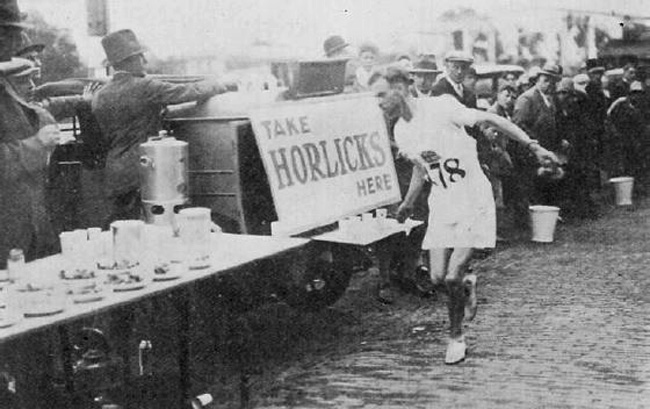The Olympic Games marathon has been long held at the Olympic Games, this athletics event having been created for the first modern Olympic Games in 1896. The comparison of the food and drinks provided to the marathon runners since the early Olympics provides an interesting snapshot of the changes in the science of sports nutrition.
Below are some snippets of information, from varying sources, which outline some of this starkly different advice given to Olympic marathons runners during different eras of sports nutrition. According to our current knowledge, a lot of the advice provided at early Olympic Games doesn't seem very practical, such as the provision of oatmeal porridge and whole lemons for the 1936 Berlin Olympics. This is the food that was provided at the 'refreshment station', though I wonder what the uptake of these items was like, and how the runners reacted to it. Can you imagine eating porridge while running, or tolerating ingesting a lemon during a marathon!
Some of what was ingested by athletes at the early Olympics are outright crazy by our standards, though by the 1936 Berlin and 1948 London games more practical and useful food and fluids were being provided to the athletes, but still not fully scientifically based. At the time, this was probably all they knew. The advice to the marathon athletes has progressed as nutrition knowledge and sport science has improved, and in the instance of the recent games in London 2012, the information provided to the marathon runners is much more comprehensive.
Developments in our understanding of hydration are evidenced by the increase in a number of feeding/drink stations provided during a race. Starting with 1 in 1904, growing to 4 in 1908, 7 in 1948, and up to 16 spots to hydrate and fuel in today’s modern marathon. This changing information gives an idea of how far sports nutrition has come as a science, and the knowledge base developed over the years of sport science research and practice.
The following are selected fascinating tidbits of information about nutrition and the Olympic Games marathon, mostly taken from the comprehensive official reports produced after each games.
1904: St. Louis USA
Some of the earliest records of dubious practices were from the 1904 marathon, the reports of what some of the athletes ingested is crazy. The marathon event in 1904 was held in St Louis, Missouri USA, on a very hot day. Unfortunately the chief organizer was interested in 'purposeful dehydration', a misguided area of scientific research at the turn of the century that believed that dehydration was beneficial to the athletes. Consequently, the organizers only allowed one water station on the entire marathon course. As well as purposely dehydrating the runners, the winner Tom Hicks had to be sustained by doses of a concoction of brandy, egg white, and strychnine during the race, which probably helped him to finish the grueling event. His trainer believed this was stimulating his nervous system, however, they would have to reconsider this recommendation, as in the end, he had to be dragged across the finish line! Strychnine is now used as rat poison, it is hard to see how such a product could be beneficial to a runner.
 Athletes refresh themselves with water during the marathon at the 1928 Amsterdam Olympic Games
Athletes refresh themselves with water during the marathon at the 1928 Amsterdam Olympic Games1908: London, England
Oxo is brand of food product that made beef stock powder in 1908 (now they make much more) and was an official sponsor of the 1908 Olympics. The Oxo Company supplied the following free of charge to the marathon competitors at the refreshment station along the route (taken from the official report of the 1908 Olympic Games):
— Oxo Athletes’ Flask, containing Oxo for immediate use. Oxo hot and cold; Oxo and Soda, Rice Pudding, Raisins, Bananas, Soda and Milk. Stimulants will be available in cases of collapse. Note.—Eau de Cologne and sponges can be had for use of competitors from the Oxo representatives who will be stationed at refreshment booths at four positions on the route
In addition, the rules listed for the marathon in 1908 included these:
4. No competitor either at the start or during the progress of the race may take or receive any drug. The breach of this rule will operate as an absolute disqualification.
10. Each competitor must provide his own attendants and required refreshments.
1912: Stockholm, Sweden
There were four refreshment stations provided at the 1912 Stockholm Games. Two at the control stations at Tureberg and Stocksund, others at Silfverdal and at the turn. The stations provided sterilized drinking water, and other refreshments such as tea, coffee, lemons and oranges for consumption by the competitors.
 Horlicks hydration station during the marathon event at the 1928 Olympic Games (image from the official report of the 1928 Olympic Games)
Horlicks hydration station during the marathon event at the 1928 Olympic Games (image from the official report of the 1928 Olympic Games)1936: Berlin, Germany
During the marathon in1936, there were eight refreshment stations. Each station was provided with the following provisions (from The XI Olympic games, Berlin, 1936: official report [volume I]):
5 liters of warm tea, sweetened with grape-sugar
5 liters of cold tea, sweetened with grape-sugar
5 liters of warm tea unsweetened
5 liters of cold tea unsweetened
5 liters of malt coffee
5 liters of orange juice
5 liters of cold lemonade sweetened with grape-sugar
5 liters of warm oatmeal porridge
½ lb. sugar in cubes
30 cubes of grape-sugar (Dextroenergen) in tablet form = 5 packages
10 bananas
10 oranges
5 whole lemons
1948: London, England
There were 7 refreshment stations for the 1948 marathon. The following rations were supplied to each station:
6 pints of warm tea
3 pints of sweetened tea
6 pints of cold tea
3 pints of sweetened tea
4 pints of warm coffee
3 pints of barley water
3 pints of lemonade
1 syphon of soda water
1 bottle of orange juice
½ lb. sugar cubes
6 oranges
6 lemons
20 cubes grape sugar
2012: London, England
The following information was provided for the athletes at London 2012, for athletes in endurance sports such as the marathon, triathlon and road cycling events (from the Olympic athletes’ medical information handbook, London 2012)
Features and Challenges
- Success is defined by the ability to sustain performance over prolonged periods
- Nutrition goals change according to the phase of training
- General preparation: high training volume training, manipulation of body composition
- Specific preparation: high-intensity training, often with specialized periods such as altitude training
- Taper/competition: lower volume/high intensity; race focus, avoidance of weight gain
- Transition: light training, small weight gain usual
- Goals during training include achieving an ideal physique, usually involving low body fat levels, and in some sports, muscularity. Competition physique may only be maintained for a short period. Some loss of physique during off-periods of the year but athletes should try to minimize this.
- Athletes are often at risk of developing issues with eating and body image
- Fatigue or decline in performance during a race may be caused by dehydration, fuel depletion, gastrointestinal discomfort and other factors.
- Opportunities for fluid and fuel intake during a race vary according to the sport, but usually require the athlete to eat or drink “on the move”. Supplies may be provided at feed zones or from team support crews or may need to be carried by the athlete.
- Competition phases differ according to sports from marathon racing where the athlete may undertake 1-2 major competitions per year to road cycling where a professional cyclist may compete on 100 days of the year.
How do they compare to the current recommendations?
Most of the food and drinks provided to the marathon runners early last century don’t seem very practical and would not have been the most ideal for improving the performance of the runners. However, some of the advice given in the past has striking similarities to modern guidance, such as the Oxo drink provided in 1908 which would have provided much-needed electrolytes and fluids for race. Also, providing tea, warm or cold, sweetened with grape sugar in 1936, would have been a great source of carbohydrates as well as including caffeine as a stimulant.
Today, the nutrition information available to athletes has evolved to be very detailed and highly individualized depending on the athlete’s needs. Recommendations include specific amounts of carbohydrate for the duration of a race, pre-race carbohydrate loading strategies, what special supplements are useful, as well as fluid intake planning for optimal hydration. See our article about Marathon Nutrition, and the Top-10 Eating strategies for Marathon Runners for more details.
Related Pages
- Nutritional Strategies for Marathon Runners
- Nutrition for the Marathon
- Olympic Games Nutrition
- Fluid and Fuel Considerations for a Fun Run
- Nutrition notes for an ultra-endurance event
- Nutrition for Endurance and Adventure Sports
- Anthropometric Measurements of Olympic Men's Marathon Champions
- Hydration in Sports
- About the marathon running event
- Marathon Major Championships Events


 Current Events
Current Events